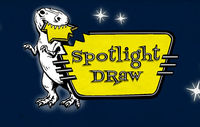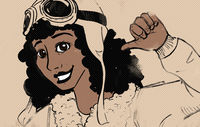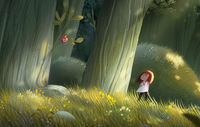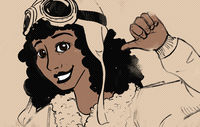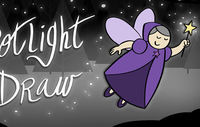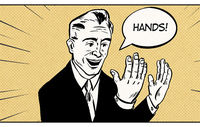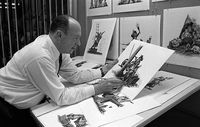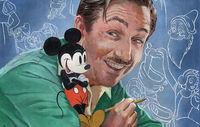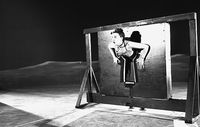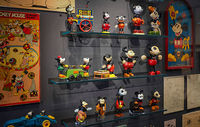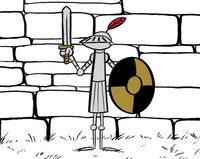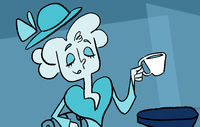Inktober is a special time of the year for artists, where every day during the month of October participants create and post original artwork onto social media using only ink as their medium. This class will have you create your own Inktober piece, provide helpful lessons about committing to your initial designs and creative instincts, and allow you to experiment with various drawing tools.
Wolfgang “Woolie” Reitherman, one of Walt Disney’s legendary Nine Old Men, animated many thrilling sequences in Walt Disney’s films. Some of his most dynamic scenes include the prehistoric battle in Fantasia (1940) between the monstrous Tyrannosaurus Rex and Stegosaurus, as well as Prince Phillip’s encounter with the menacing dragon in Sleeping Beauty (1959).
Wolfgang “Woolie” Reitherman, one of Walt Disney’s legendary Nine Old Men, animated many thrilling sequences in Walt Disney’s films. Some of his most dynamic scenes include the prehistoric battle in Fantasia (1940) between the monstrous Tyrannosaurus Rex and Stegosaurus, as well as Prince Phillip’s encounter with the menacing dragon in Sleeping Beauty (1959).
In this fun and hands-on session, learn how to make your drawings truly come to life and put your creativity in the spotlight. For artists of all ages, learn step-by-step instructions on how to draw an original cartoon character.
Eric Larson, one of Walt Disney’s legendary Nine Old Men, was the animator behind the some of Disney’s most memorable flight sequences. From the graceful Pegasus in Fantasia (1940), to Peter and the Darling children soaring over London in Peter Pan (1953), Larson had the impeccable ability to animate any creature.
Walt Disney held many titles during his career—award-winner, innovator, filmmaker—but above all else, he was a master storyteller. From animation to live-action features, Walt believed it was crucial to tell a good story.
Eric Larson, one of Walt Disney’s legendary Nine Old Men, was the animator behind the some of Disney’s most memorable flight sequences. From the graceful Pegasus in Fantasia (1940), to Peter and the Darling children soaring over London in Peter Pan (1953), Larson had the impeccable ability to animate any creature.
In 1936, Walt Disney felt that Mickey Mouse needed to return to the public eye and planned to feature him in a short piece called “The Sorcerer’s Apprentice”. The thought to expand the project into a feature film that combined animation and classical compositions led to what we now know as Fantasia (1940).
Enjoy light refreshments and connect with other educators while exploring the museum’s galleries. Take an interactive tour of our special exhibition Walt Disney’s Nine Old Men: Masters of Animation and then visit the Learning Center to preview the Education Department’s newest school experience offerings for the 2018–19 academic calendar.
In this fun and hands-on session, learn how to make your drawings truly come to life and put your creativity in the spotlight. For artists of all ages, to learn step-by-step instructions on how to draw an original cartoon character. This month’s theme is presented in conjunction with our daily screening of Cinderella (1950).
Milt Kahl, one of Walt Disney’s legendary Nine Old Men and considered by some as the Michelangelo of animation, gave life to unforgettable characters like Pinocchio, Alice, Madam Mim, and Peter Pan. In fact, Kahl quickly became known for his impeccable and realistic design skills, especially when it came to his character’s hands.
Never wanting to be confined to limits of one medium, one of Walt Disney’s star animators, Marc Davis, was truly a renaissance man. After Davis had spent more than 20 years as one of Walt’s key animators, Walt transferred him to Imagineering, where he would contribute iconic story and character concepts to some of the most memorable attractions in theme park history.
Walt Disney had a colorful and illustrious life that black and white photographs don’t often pay enough justice, and which was only rarely captured on film. Former Disney animator and fine artist John Pomeroy set about capturing Walt’s unique story with his paintbrush, while creating a masterfully illustrated children’s biography for the award-winning Big Words series.
Tinker Bell is one of the most iconic characters to emerge from the legacy that Walt Disney left behind, and behind every great character was real-life inspiration.
Take your Walt Disney Family Museum membership out on the town and enjoy complimentary admission to the partner museums listed below. Present your Walt Disney Family Museum membership card to obtain two free admissions per membership at each location; some restrictions apply.
In this fun and hands-on session, learn how to make your drawings truly come to life and put your creativity in the spotlight. An instructor will teach you step-by-step instructions on how to draw an original cartoon character. This workshop is for artists of all ages.
Walt Disney would bring animals or actors into the Studios for his artists to study in preparation for an animated project. Walt felt live action reference was crucial for an animator to understand the natural movement and design of a subject they were about to animate.
Walt Disney would bring animals or actors into the Studios for his artists to study in preparation for an animated project. Walt felt live action reference was crucial for an animator to understand the natural movement and design of a subject they were about to animate.
In the animated short Toot, Whistle, Plunk and Boom (1953), Walt Disney and his team of animators, stylized the film with heavy influences from mid-century cubist art. Ward Kimball, a co-director of the Oscar®-winning short, wanted to experiment with the fundamentals of this new world and recruited artists Tom Oreb and Marc Davis to help further the designs of the project.




